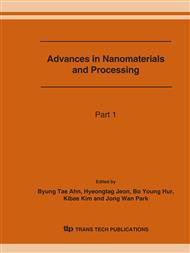p.1361
p.1365
p.1369
p.1373
p.1377
p.1381
p.1385
p.1389
p.1393
Effects of Oxygen on Phase Stability and Mechanical Properties of Quenched Ti-Nb Alloys
Abstract:
The effects of oxygen content on microstructures, elastic modulus and tensile properties of quenched Ti-Nb alloys were investigated in order to design a desirable Ti based alloy through casting process. From the microstructural and phase analysis, it is evidently revealed that the volume fraction of β phase increased with increasing content of oxygen, and the occurrence of intermediate ω phase was suppressed in metastable β Ti-Nb based alloys. Martensite transformation temperature decreased with increasing content of oxygen. Therefore, it is suggested that oxygen acts to stabilize β phase rather than α stabilizer in quenched state. Yield strength increased with increasing content of oxygen without a large consumption of ductility in metastable β Ti-Nb based alloys. The variation of mechanical property was explained by the phase stability, phase formation and microstructure in correlation with oxygen and Nb content.
Info:
Periodical:
Pages:
1377-1380
Citation:
Online since:
June 2007
Authors:
Keywords:
Price:
Сopyright:
© 2007 Trans Tech Publications Ltd. All Rights Reserved
Share:
Citation:


